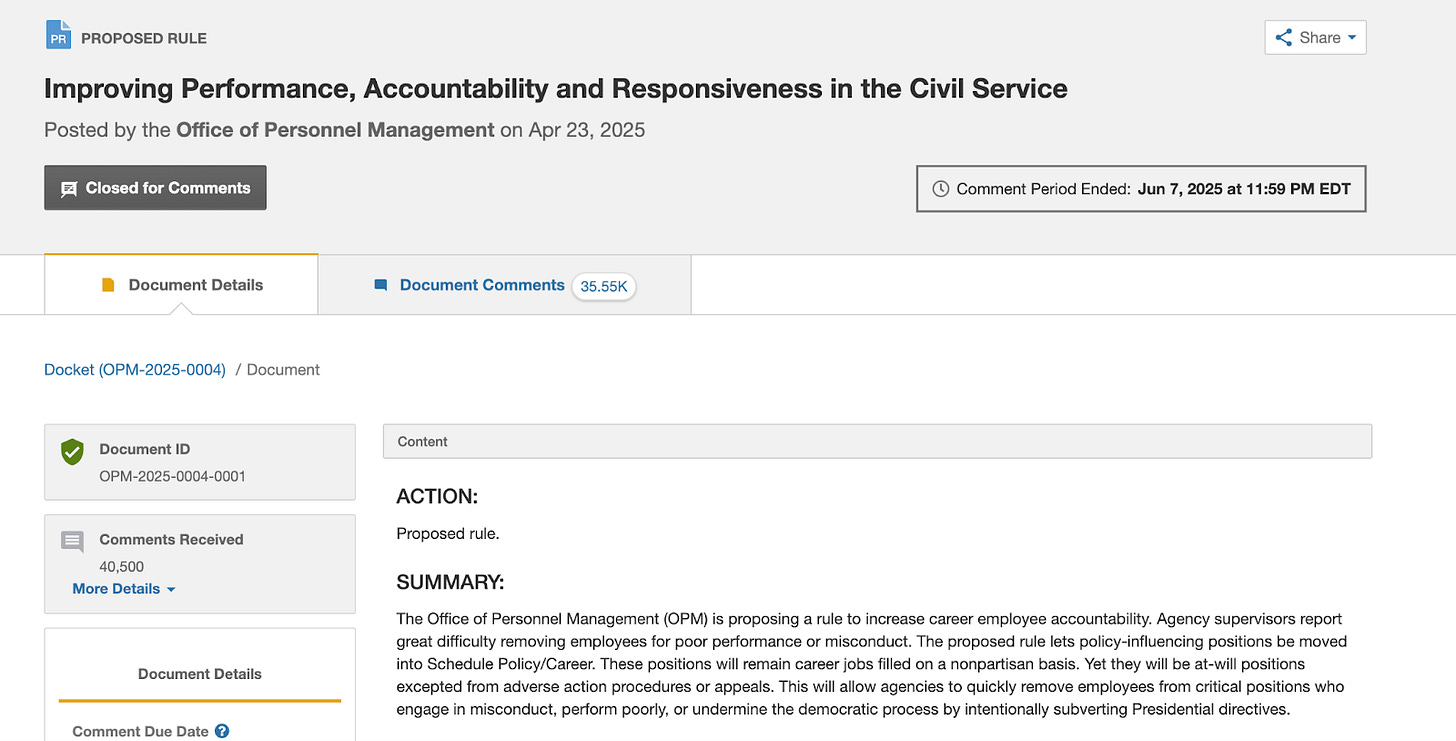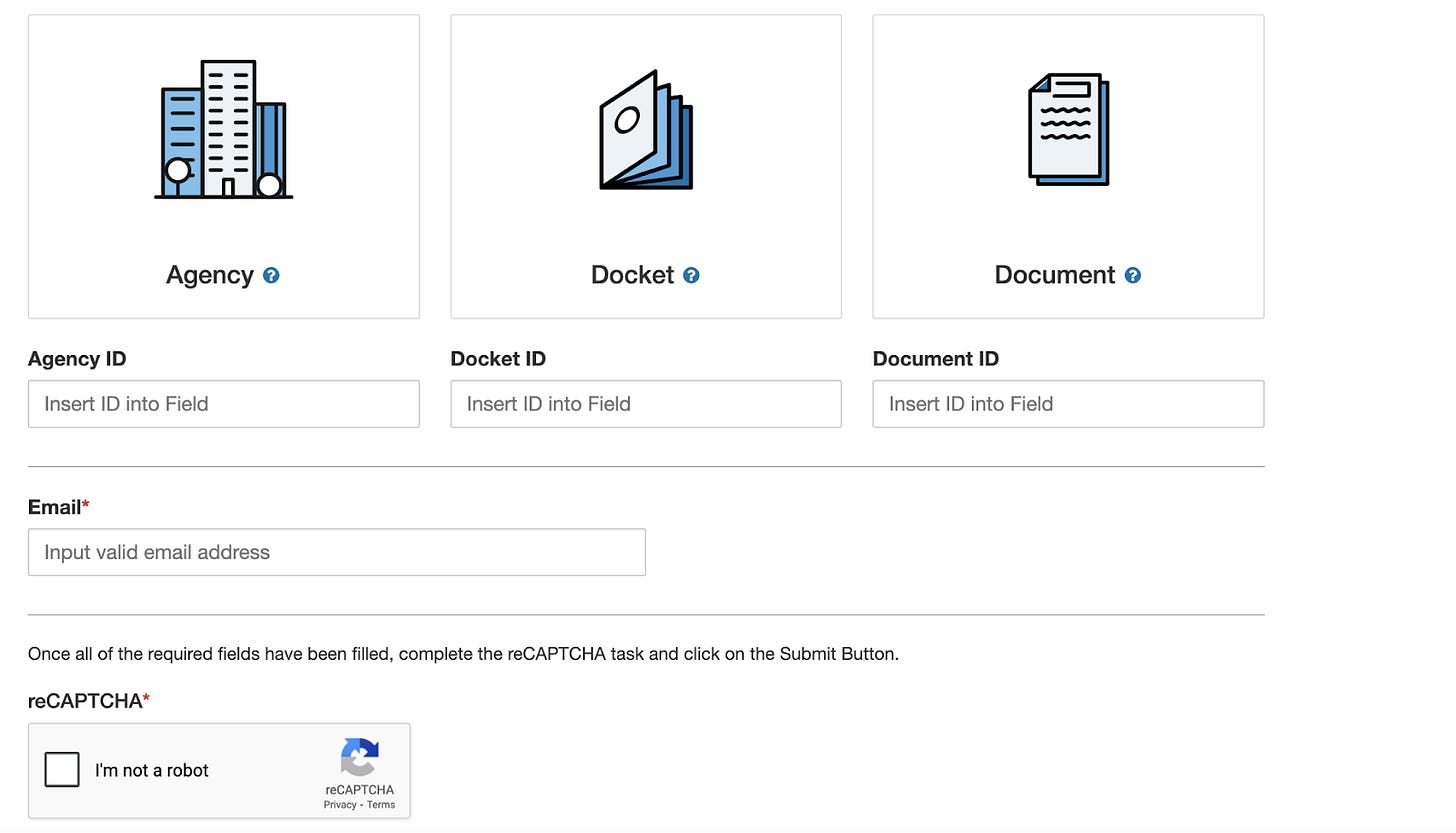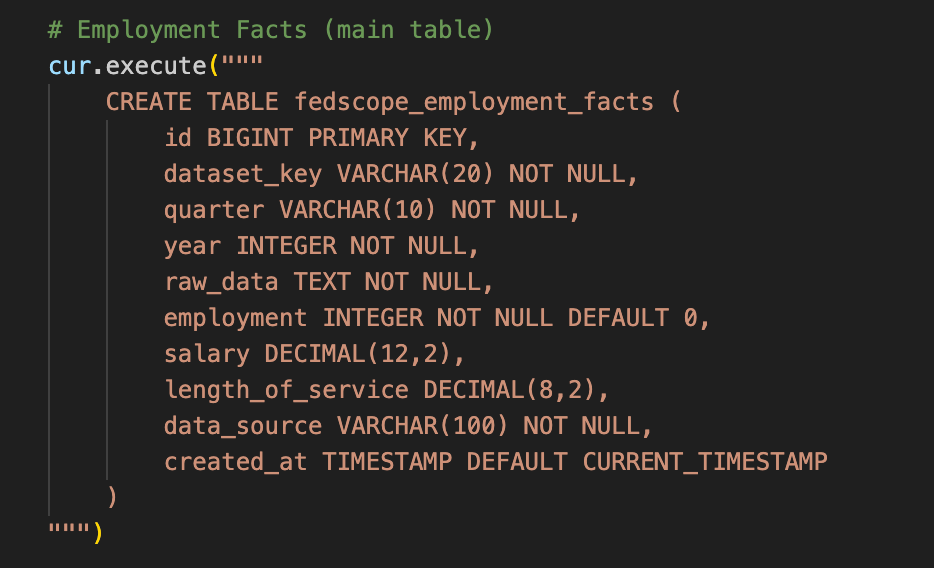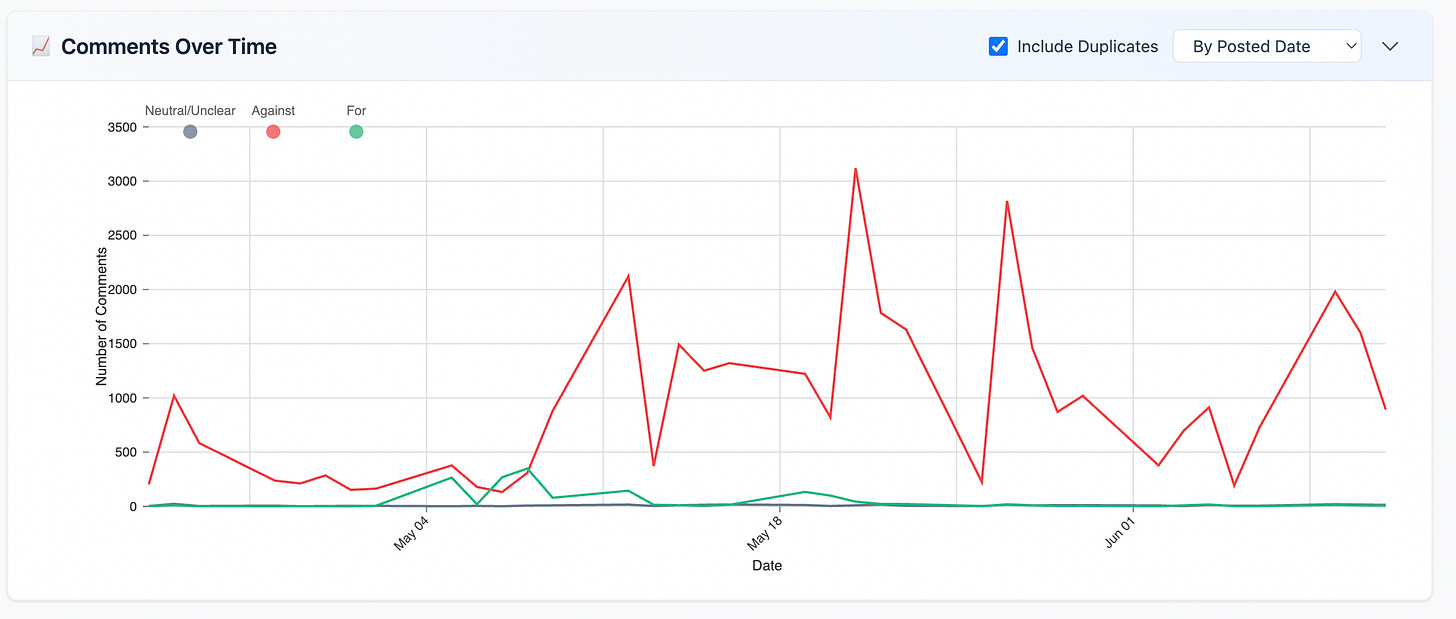My Text Pipelines Meet The Real World
Analyzing 35k comments on Schedule F
A few months ago, I realized that most of my projects—for work and not-work—had a similar structure:
Get text: This might involve getting text directly from users, pulling it from PowerPoints or PDFs, or collecting it from an LLM that you're evaluating.
Process that text: This might involve an LLM, but it also might involve regular expressions for pattern matching, BERT for classification, or another single-purpose model like language classification or translation.
Do something with the results: Sometimes this is just making heat maps or other result visualizations. Sometimes I'm displaying results for a user, or populating PowerPoint slides or other templates with structured data.
Via my various projects, I’d written code and picked up some design patterns I liked. So I set out to build something that would show this approach in action—while also making something useful.
Analyzing public comments on the proposed regulation to remove civil service employment protections from many federal government employees seemed like a great use case. And how different could it be from what I'd done before?
The basic structure was the same:
Get text: Use the API to download comments from regulations.gov
Process text: Use LLMs to categorize stance and themes
Do something: Build a searchable web interface to explore results
My goal was to use existing code and build new modular elements that I could continue to re-use on future projects.
The project ended well. But it didn’t go the way I’d imagined.
Instead, I learned that I had a few Lego blocks for different capabilities, but I needed WAY MORE. Each new requirement—scale, the ability to resume processing, a real frontend—demanded specialized pieces I hadn't built before, some of which were unique to this project and I probably won't need again.
These were mostly downstream of the number of comments that needed to be processed. But some had to do with the range of attachments I was processing, my comfort in terms of how solid the engineering needed to be (like, deciding that we did need to process most of the attachments, but not the very most difficult ones), and also all the ways that reality intruded on my neat architectural plans.
Scale Changes Everything
My previous pipelines had a luxury I didn't appreciate: they were small, on the order of hundreds or a few thousand rows.
This had two benefits.
First, when I changed something, I needed functionality to test on a small subset to see if it was working, but then I could just re-run my whole pipeline.
But when you’re trying to periodically update a website as new data comes in, and you have tens of thousands of comments? That's different.
Suddenly I needed the ability to pick up when new data was added, instead of starting at the beginning. I also needed a lot more retry logic, logging/monitoring, and robustness as far as running when I wasn't sitting at my computer.
And the resuming requirement cascaded through everything. For instance, I built a manual relabeling tool to check the LLM's categorizations and change them when they were incorrect. The frontend for this wasn't complicated—it was an interface to show comments and let me change labels. But tracking what changed while maintaining the ability to resume, as well as the ability to run the pipeline from the start while keeping my corrections? I eventually abandoned it because the complexity wasn't worth it.
But also, the API I was using to pull the comments from regulations.gov was not set up to pull this much data out of it, so I had to switch to the bulk data download. This meant my pipeline couldn't truly be autonomous—I had to start by clicking through and solving the captcha to ask for the updated data set, and then download it from the website and put it in my repo folder.
And finally, in previous projects, because there was so little data, I could use a lightweight JavaScript front end which did all of the work in the browser, as opposed to needing a back end to filter the data. But because of the size of the data set this time, my lightweight, modular front end was no longer going to work because it would overwhelm the browser: I needed an actual database and front end engineering.
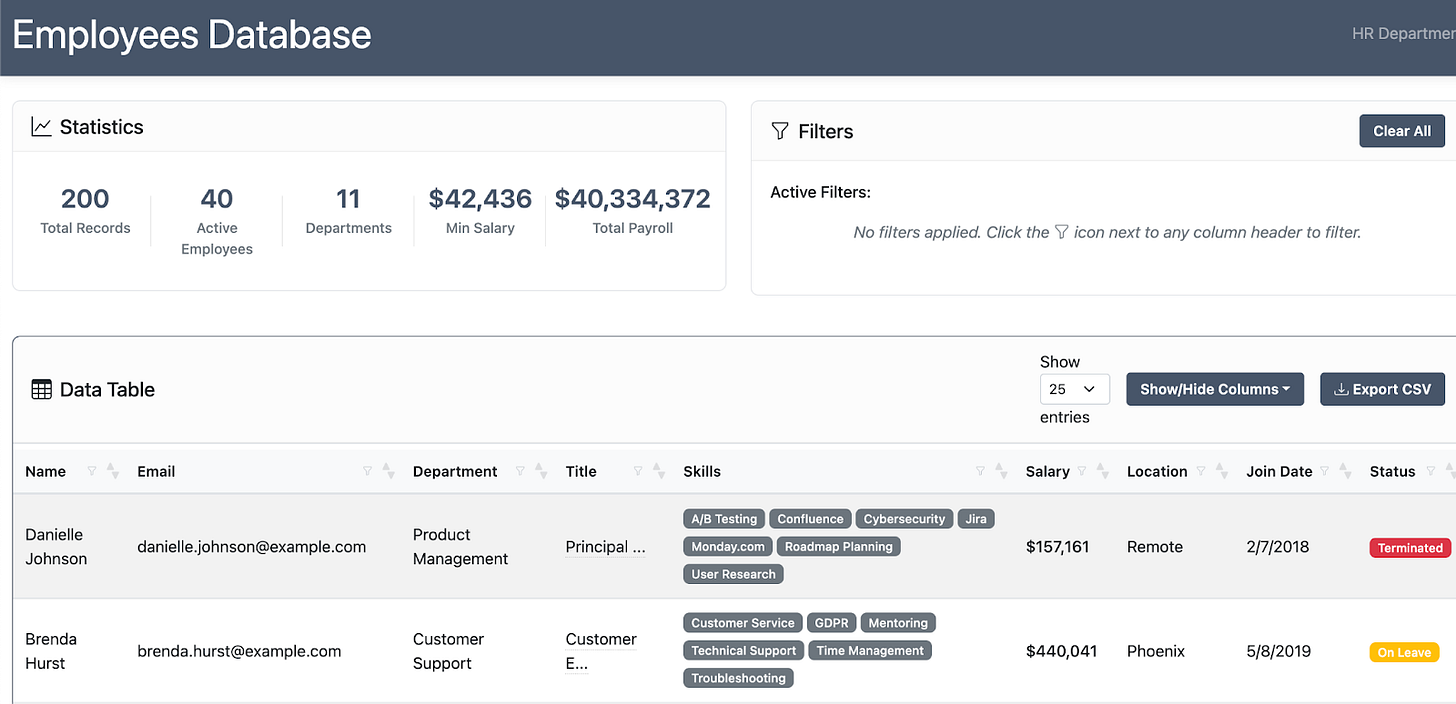
Luckily, with LLMs, I was able to easily and painlessly spin up a front end myself with no fuss.
Wait, I got that wrong. What I actually meant to say was: I started working with Michael Boyce, who engineered the front end so I could focus on the data pipeline.
Needing More Infrastructure
Working with an engineer meant I needed different infrastructure blocks—but it also meant we could build things I couldn't have done alone.
First, a note on the importance of schemas. When I was doing the front end myself in my very modular way, it didn't matter much if a field name changed or I added in a new one. I had a config file and I could just update it with a new field name. No need to touch the .css, .html, or javascript. Simple.
But when someone else is building the frontend, that schema—the exact structure and names of your data fields—becomes a contract. The frontend expects specific fields in specific formats. Change the schema, break the frontend.
For this project, I added a data validation step to my pipeline to make sure I was outputting the fields I said I would in the formats I said I would.
Now, in my new projects, I define database schemas up front, I’m cautious about changing them, and I upload the data directly to PostgreSQL myself.
Custom development also opened up possibilities I hadn't considered. My previous approach had some summary statistics, which the config file also let you tweak depending on what stats and fields you wanted to show. The main event was the table, which you could filter and search.
But now, with custom development, we could add a line chart showing comments over time. We could add embeddings (numerical representations that let you find similar comments) and clustering to group similar ones together.
This also meant that even though I was no longer handling the front end, there were more Lego blocks I needed to build to produce the necessary fields for it.
The Seven-Cent Epiphany
Here's my favorite example of bringing the wrong Lego blocks to the project.
I'm comfortable with local text processing of PDFs or Word documents. So that's where I started.
But then I realized there was a whole weird range of documents people attached to their comments. PDFs that were dark and scanned. JPGs of memes. (Really!)

I built the basic local text extraction with PyPDF2 for PDFs and python-docx for Word documents. When that was leaving me with some unprocessed documents, I started doing local OCRing with tesseract to extract text from the images. But that wasn't working great, and also it was difficult to tell WHEN it wasn't working, because it would extract text, but that text was sometimes gibberish.
I was reluctant to add Gemini—Google's multimodal AI that can read text from images—to the process because I was worried it would add another expense to this project, on top of processing comments with an OpenAI model.
Then I just tried it.
It cost me seven cents to run the entire set of attachments that initially failed to process through PyPDF2 or python-docx through Gemini.
I deleted the local OCR code.
The big benefit was this let me drop my janky functionality for figuring out whether OCR'd text was actual, real English or crazy wrong-OCR'd text. Which was a capability I really did not want to have.
But for a different project, with a different set of constraints—for instance, needing to process everything locally—I would have had to figure out attachment processing without just going to Gemini. (And there are various models that are bigger and more capable than what I tried locally this time around.)
Reusability Where I Didn't Need It
I did wind up reusing some of my code from previous projects.
My approach to LLM calls from previous repos was also what I needed here: to pass a class with a particular structure—a template for what kind of response I wanted back. For instance, to get back a list of themes where it would only choose from the ones I gave it and not make up any more, or an "agree/disagree/neutral" for the comment overall categorization.
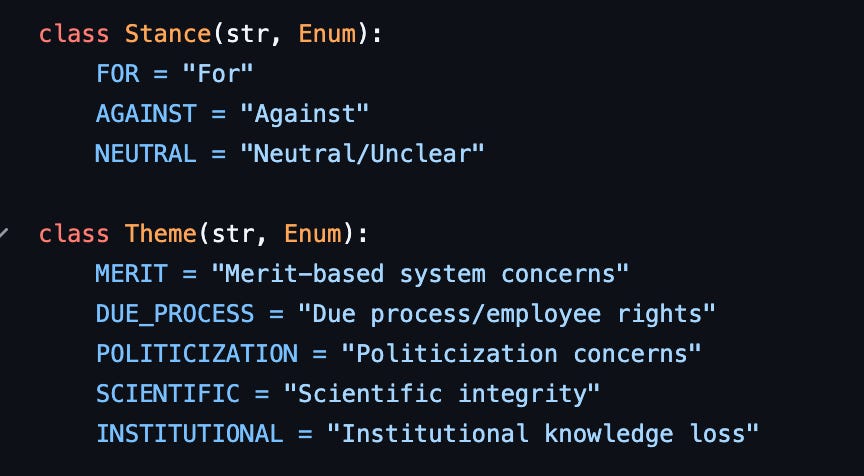
But this was a tiny part of the overall system. And even for the LLM calls, there were bespoke elements of the pipeline.
For instance, a lot of the comments were repeats of each other, so I didn't want to send them to the LLM individually. And also, some of them were extremely long. Instead of sending each comment in full, I both truncated each comment to its first 1,000 characters and only sent that unique text once.
That required building infrastructure to track which truncated text mapped to which comments, and then merge it back into the original dataset—because we didn’t want to lose the full text.
This cut my LLM costs and time to run, but what other project would need exactly this optimization?
You can build reusable solutions, but they only work within their design constraints. Step outside those constraints and you're back to custom code.
The Next Pipeline
If your pipelines are really standardized, you only need a few Lego blocks. Same scale, same format, same output? Great, reuse everything.
But each new surprise—35,000 comments, memes as attachments, the need to truncate and group by—means more blocks. And if you're building tools for other people's problems that you haven't even seen yet? You need way more blocks than you think.
My lightweight frontend worked great until it didn't. My local text processing handled everything until someone attached a blurry JPEG. Seven cents to Gemini later, I deleted a whole chunk of code I was thrilled to delete and hope to never need again.
The pattern stays the same—get text, process it, do something with results. But the blocks keep multiplying.
My next pipeline? No LLM, no clustering (yet)—just APIs and web scraping and then mapping the data to standard fields.
Same structure, new Lego blocks. Again.

